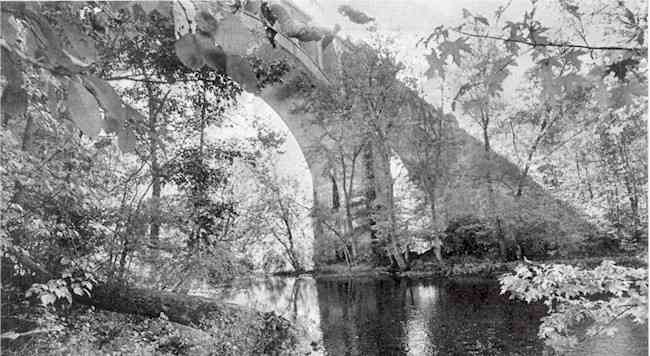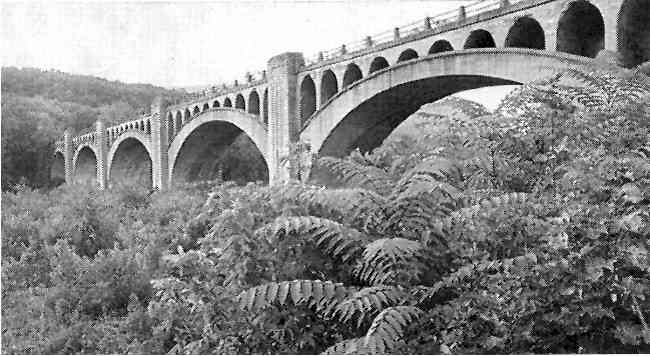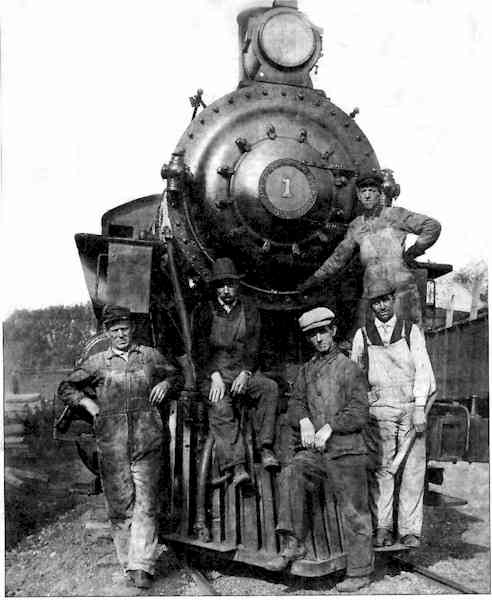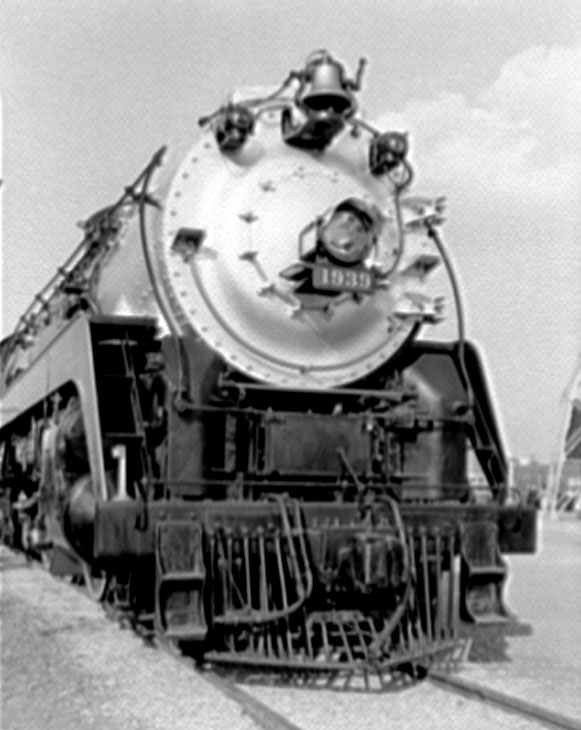Bring the Old Railway Lines Back
NJ Transit Sees Future in the PastThe curtain rises on a vast primitive wasteland, not unlike certain parts of New Jersey. - Woody Allen
When coal had to be carried to Hoboken, viaducts like the ones in Hainesburg (above) and Columbia (below) were built. Officials want to bring the line back.
by Caren Chesler Resurrecting Old Track and Laying New LinesIn 1865, the Delaware, Lackawanna and Western Railroad carried anthracite from Scranton, Pennsylvania to Hoboken. The freight of coal moved easily through Pennsylvania, but once it crossed the Delaware River, the trains had to slow down for the next 40 miles as the track undulated through the mountains and lakes of northern New Jersey. Vowing to make the line more efficient, the railroad's president, William Haynes Truesdale, is said to have stood on the line's highest point and told builders to construct the straightest route possible. If hills and lakes got in the way, the builders were told to build over them. Huge viaducts of reinforced concrete were erected, scores of bridges were built and 15 million cubic yards of fill were used to make the line level. When it was completed a decade later, the line was 11 miles shorter and hailed as an engineering marvel. But then the Depression came, and the region's reliance on coal diminished. Increasingly, manufacturers began transporting freight by truck and the 40-mile stretch of track - dubbed the Lackawanna Cutoff - was eventually taken out of service in 1979. State officials now want to bring it back. In May, New Jersey Transit purchased the line for $21 million with the hope of reintroducing rail service to northern New Jersey, where the population is exploding and the roads are reaching capacity. And it is only one of several train lines transportation officials are dusting off to alleviate traffic. New Jersey Transit plans to spend about $9 billion over the next decade to resurrect old rail lines, lay new track and add trains with the goal of moving 69,000 people off the highways and onto the railroad. Transit officials plan to resurrect the New York, Susquehanna and Western Line, between Sparta and Paterson. There are plans to use a strip of the old Jersey Central Railroad in Monmouth and Ocean Counties for commuter rail service. And a 21-mile stretch of the track between West Trenton and Bound Brook may also be resurrected. New Jersey Transit also plans to convert nearly half a dozen light rail lines. The Hudson Bergen Light Rail is already operating between western Jersey City and the Newport Center mall, but it will be extended to the Hoboken PATH terminal by late 2002 and eventually into the interior of Bergen County. A light rail system is being built in South Jersey, between Camden and Trenton, and another is being built in Newark, connecting the city's two business districts. There are also plans for a light rail line in Union County, connecting downtown Elizabeth with Newark International Airport. A new train station will also be opened in Secaucus, enabling 32,000 passengers to commute directly into Manhattan and shave 15 minutes off their commute. Morris and Essex Line passengers would get off the train at Secaucus and transfer to the Northeast Corridor or North Jersey Coast Line, the only two lines that go all the way into New York. The theory is that if the commute is made easy, the riders will come. Still, they may not get a seat, says Jeffrey Warsh, executive director of New Jersey Transit. Many trains are already operating at 130% capacity, and once the Secaucus station opens, seating will only get worse. The agency hopes to ease the problem by running trains with 12 cars instead of 10. And it also plans to purchase 200 double-decker train cars. "They will not get a seat in the short run," Mr Warsh said. "But we will be returning 10 hours a month to people's lives at a time when that time couldn't be more precious." But if state officials build everything that is now on the drawing table, seating will not be the only problem. Transit officials will have to contend with train traffic waiting to get through the one tunnel into New York, and Mr Warsh says another is needed if the state wants to continue to expand rail service. "Once we squeeze all the juice out, that's it until we have a tunnel," Mr Warsh said. "We will have done everything we could possibly do to address the capacity by 2005." For now, state officials propose building a new tunnel underneath the existing one, at a depth of 145 feet. A second tunnel would run underneath Manhattan, connecting Pennsylvania Station and Grand Central Terminal. A third tunnel underneath the East River and into Queens would then be needed so that trains could turn around before returning to New Jersey. Mr Warsh said the project - currently in the fact-finding stage - will cost from $3 billion to $5 billion. Mr Warsh remains optimistic, saying all the projects will eventually be built after obtaining federal funds and overcoming local opposition. He cited the Montclair Connection, a 1,500-foot strip of track linking the Montclair branch to the Boonton line. The project was started in 1992 but was stymied several times by local residents because it required the destruction of several homes. It will finally be completed in the next couple of months. Douglas Bowen, vice president of the New Jersey Association of Rail Passengers, a grass roots organisation, said the opposition often came from people in the suburbs who want access to the inner cities but do not want the inner cities to have access to the suburbs. "They think if you build light rail, people will steal their TV's and get on the light rails," Mr Bowen said. "It's suburban folklore." Others fear - incorrectly, in many cases - that train lines lower property values, Mr Bowen said. People who live along Essex Street in Jersey City, where the Hudson Bergen Light Rail has been re-established, were convinced the line would destroy their neighbourhood. "I couldn't buy what those places are going for now," he said. Source: The New York Times Sunday 30 December 2001; photo credit Nancy Wegard
From US Representative Rodney Frelinghuysen's "Reports to New Jersey" Spring 2003:
Representative Freylinghuysen can be reached at house.gov/frelinghuysen
If you're interested in New Jersey's abandoned railroad bridges, visit xydexx.com/modernruins for pictures of the inside of the Paulinskill Viaduct, the abandoned railroad bridge which spans the Paulins Kill in Hainesburg. Completed in 1911, it was part of the Lackawanna Cutoff before being abandoned in the 1960s.
I've Been Working on the Railroad...
Source: whippanyrailwaymuseum.org see also Morris County Historic Photo Album
The Lackawanna
For more articles on New Jersey including facts, census data, complex highway interchanges, photos, transit plans, politicians, geology, canals, regions, governance, flora and
fauna click the "Up" button below to take you to the Table of Contents for this section. |
 Animals
Animals Animation
Animation Art of Playing Cards
Art of Playing Cards Drugs
Drugs Education
Education Environment
Environment Flying
Flying History
History Humour
Humour Immigration
Immigration Info/Tech
Info/Tech Intellectual/Entertaining
Intellectual/Entertaining Lifestyles
Lifestyles Men
Men Money/Politics/Law
Money/Politics/Law New Jersey
New Jersey Odds and Oddities
Odds and Oddities Older & Under
Older & Under Photography
Photography Prisons
Prisons Relationships
Relationships Science
Science Social/Cultural
Social/Cultural Terrorism
Terrorism Wellington
Wellington Working
Working Zero Return Investment
Zero Return Investment


